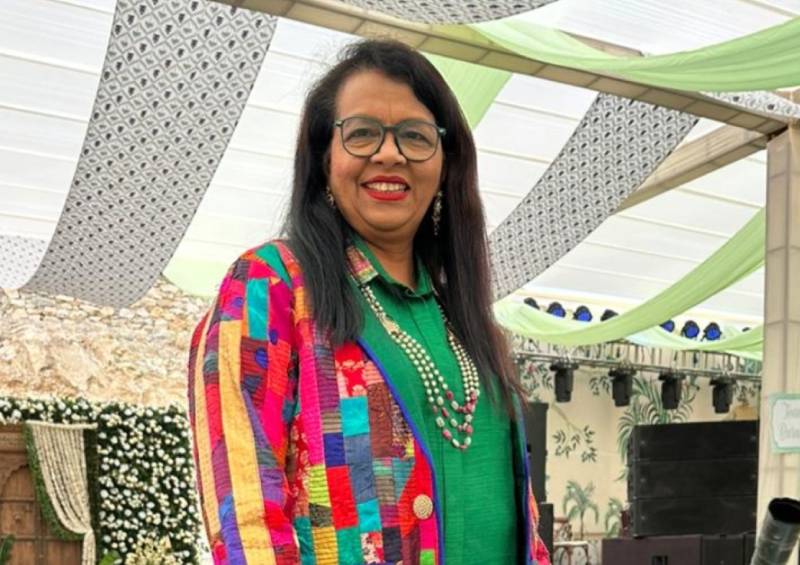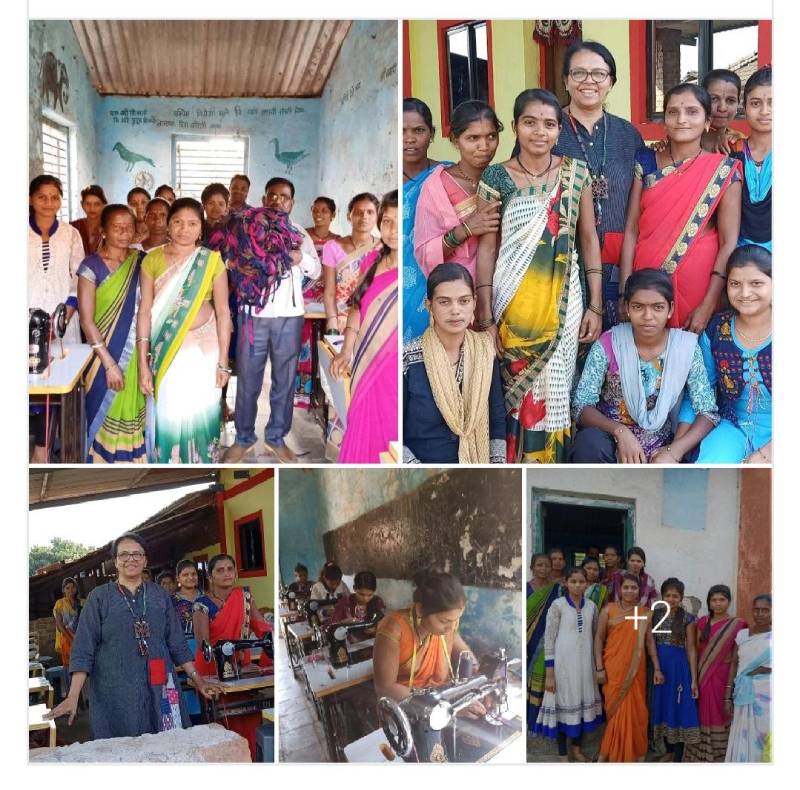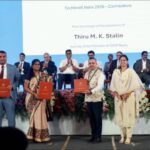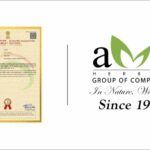Bunko Junko: Crafting Wearable Art & Empowering Women With Textile Scraps!

Bhavini Parikh, the visionary Founder & CEO of Bunko Junko, candidly shares the inspiring story behind her transition from surface ornamentation to becoming a trailblazer in the world of textile upcycling in this captivating conversation with Henry Dsouza, Associate Editor of Textile Insights. Parikh unravels the intricate threads of sustainability, women’s empowerment, and the transformative journey that defines Bunko Junko’s commitment to environmental responsibility.
Let’s dive into the heart of upcycling, a concept often overlooked in the shadow of recycling. Can you shed light on the significance of upcycling in the circular economy, especially your focus on pre-consumer textile upcycling?
Upcycling takes precedence in the circular process, coming before recycling. There are two types of upcycling: pre-consumer and post-consumer. Pre-consumer involves utilizing scraps, side cuts, misprints or defective fabrics rejected during quality checks. Post-consumer upcycling occurs after garment use, involving reselling or repurposing the same garment. Only after these stages does the material typically move towards recycling.
At Bunko Junko, our primary focus is on pre-consumer textile upcycling. Many fabrics and garments are rejected during quality checks, even due to small stitching errors or misprints. This results in numerous scraps, which we creatively transform into different garments or home furnishing accessories. We operate with a zero-waste approach, converting any remaining material into seed paper—used for ‘Thank You’ cards or story pages that can grow into plants when discarded.
It’s about creating a circular process where upcycling paves the way for recycling. Our mission is to spotlight upcycling’s potential, an underdog in the sustainable fashion narrative.
Your journey from surface ornamentation for established brands to founding Bunko Junko is intriguing. What inspired this transition and how does environmental sustainability play a role in your brand’s ethos?
Bunko Junko was born out of my passion for environmental sustainability and women’s empowerment. I have been in the fashion industry for over 34 years, exclusively working with women since the 1990s.
In 2009, I embarked on my own journey, offering white-label services encompassing design, production and packaging for various brands, both big and small. I earned recognition as “Bhavini Behan” for my Desi work, collaborating with notable names like Shopper Stops, Anita Dongre, Vira Enterprise, Ethnicity, Maya Group of Companies, and Karishma Group.
As my career progressed, I encountered textile scraps, prompting me to explore creative ways to repurpose them. We began crafting products from scrap garment materials, and to our delight, people embraced our work at exhibits. Further research revealed the alarming environmental impact of the textile industry, motivating me to take action. While textile upcycling may not yield significant financial returns at the moment, my commitment lies in making a positive impact rather than monetary gain. I firmly believe that hard work will eventually bring financial success, and my primary goal is to contribute to a sustainable future.
The name “Bunko Junko” has a unique ring to it. How did you come up with this distinctive moniker, and what does it symbolize for your upcycling brand?
While discussing potential names with my daughter during an evening walk, she suggested “Junk” since we were re-purposing materials, but it didn’t quite resonate with us. Cleverly, she combined “Junk” with her name initial “J,” resulting in “Junko.” Recognizing the need for a personal touch, I incorporated my initial “B,” giving birth to the name “Bunko Junko.” The name pays homage to my initial (B) and my daughter, Capt. Jill (J).
Bunko Junko, a brand conceived during a simple walk, embodies the Japanese concept of ‘art decoration creation,’ seamlessly transforming discarded materials into beautiful wearable art—a testament to turning wastefulness into green resources.
How does Bunko Junko minimize the fashion industry’s carbon footprint and landfill impact through textile scraps repurposing?
Bunko Junko plays a significant role in reducing the fashion industry’s carbon footprint and minimizing landfill impact by repurposing textile scraps. Instead of contributing to landfills, we creatively transform these scraps into various products, such as garments and home furnishing accessories, extending their lifecycle. This not only lessens the environmental impact by reducing carbon emissions and minimizing energy and water usage, but also creates a substantial social impact by empowering women through employment opportunities and preventing garments from ending up in landfills.
Bunko Junko’s role in minimizing the fashion industry’s carbon footprint is commendable. Can you elaborate on how your brand achieves this through the repurposing of textile scraps?
At Bunko Junko, we source scraps from garment manufacturing units, leveraging my connections in the industry. These scraps are then sorted based on size, shape and colour requirements before undergoing a re-cutting and sanitization process. After this, women artisans take over, stitching the fabric pieces. The resulting fabric is sent to the factory for garment production, tailored to meet specific design requirements.
We create a diverse range of products, including jackets, crop tops, pants, wedding wear, bags, bed sheets, detachable belts, carry bags, laptop bags, laptop sleeves, tote bags, and more. Our product categories are determined by the available scrap materials, as our priority lies in utilizing the materials rather than adhering to specific categories.
Empowering women seems to be a core value at Bunko Junko. How do you engage and uplift women in your workforce, and what strategies have proven successful?
Bunko Junko actively empowers women in its workforce through various strategies. We collaborate with NGOs and juvenile institutions, leveraging existing connections to train women in garment stitching. Some women are personally trained, while others receive online training.
We also have a system where women take cut materials home to stitch into fabrics. Recognizing the responsibilities these women have at home, we provide them with flexibility, allowing them to work from home. They are compensated well on a job-work basis for their valuable contributions.

Challenges often accompany innovation. What hurdles have you faced in building the Bunko Junko brand, and how are you addressing them?
Challenges are part of the journey. Currently, team building and marketing pose hurdles due to financial constraints, but we’re optimistic about overcoming them. GST on scrap materials and a lack of upcycling compliances present regulatory challenges, but we see promising steps from the government and the Ministry of Textiles in addressing these concerns. Awareness remains a challenge, but our commitment to education and workshops aims to change that narrative.
Your products have found a home both online and offline. Where can readers explore Bunko Junko’s unique creations, and what makes your approach to sales distinctive?
Our creations are available on our website and through various platforms like Amazon, Brown Living and OneGreen. While online sales present challenges due to the uniqueness of each product, we aim to overcome this through storytelling and immersive experiences. We’re not just selling products; we’re sharing a journey of transformation—one scrap at a time.
In closing, what’s your vision for Bunko Junko’s future impact on women empowerment and environmental awareness in the textile industry?
My vision is to empower women beyond numbers—creating a legacy of entrepreneurs. In terms of environmental impact, we aim to share our knowledge far and wide, especially with the younger generation. Through workshops, we want to spark a revolution in textile upcycling, turning the tide towards sustainability. Bunko Junko isn’t just a brand; it’s a movement—one that breathes life into discarded materials and redefines the narrative of environmental responsibility in the textile industry.














